 Sylvia Plath’s The Bell Jar is an exploration of mental illness, identity, and societal expectations, capturing the intricacies of depression and the suffocating pressures of the 1950s American Dream. The book The Bell Jar by Sylvia Plath is an introspective deep dive into themes of depression and suicidal ideation. Although the book is suitable for high school students, I found Sylvia Plath’s writing to be beautiful. The story delves into the mind of the character as she grapples with her depression and sexuality. I am a huge fan of the 1960s aesthetics, with some of my favourite shows, like Mad Men, which portrayed this pivotal time of the subjugation of white housewives and the idealized version of the American Dream. For a character like Esther, who seemingly has a better situation than other marginalized groups in America during that period, I found her discontent and dread of the American Dream striking for someone who seemingly “has it all”.
Sylvia Plath’s The Bell Jar is an exploration of mental illness, identity, and societal expectations, capturing the intricacies of depression and the suffocating pressures of the 1950s American Dream. The book The Bell Jar by Sylvia Plath is an introspective deep dive into themes of depression and suicidal ideation. Although the book is suitable for high school students, I found Sylvia Plath’s writing to be beautiful. The story delves into the mind of the character as she grapples with her depression and sexuality. I am a huge fan of the 1960s aesthetics, with some of my favourite shows, like Mad Men, which portrayed this pivotal time of the subjugation of white housewives and the idealized version of the American Dream. For a character like Esther, who seemingly has a better situation than other marginalized groups in America during that period, I found her discontent and dread of the American Dream striking for someone who seemingly “has it all”.
As a Ghanaian first-generation Black woman, I didn’t completely relate to the sentiments Esther experienced; I felt she was a bit ungrateful for her situation. Still, her nuanced struggle with identity and purpose resonated. The Bell Jar underscores the universality of existential monotony, even as it invites readers to consider their own cultural lenses and lived experiences.

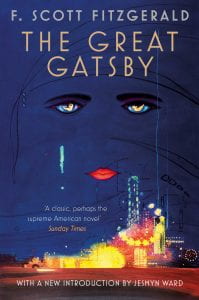 F. Scott Fitzgerald’s The Great Gatsby is a timeless exploration of the American Dream. The author adopts the introspective narrative tone of Nick Carraway. Through Nick’s eyes, we get to experience the prosperousness and disillusionment of the Jazz Age, as well as the moral struggle of the character and the author himself.
F. Scott Fitzgerald’s The Great Gatsby is a timeless exploration of the American Dream. The author adopts the introspective narrative tone of Nick Carraway. Through Nick’s eyes, we get to experience the prosperousness and disillusionment of the Jazz Age, as well as the moral struggle of the character and the author himself.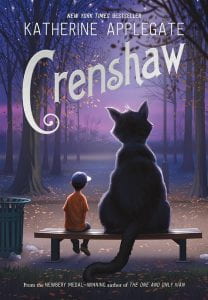 “Crenshaw” by Katherine Applegate is the story of Jackson, a nine-year-old boy and his imaginary large feline friend, Crenshaw. Jackson’s family struggles to make ends meet, and Crenshaw appears each time Jackson is going through a hard time navigating things. Though his family tries to shield him and his younger sister from the realities of their situation, Jackson knows a lot more than they think. He is very loving and understanding but wants to change his family’s situation and wishes his parents would open up to him about their realities. Crenshaw appears to him at five, showing up in a bathtub. He’s outspoken, distinguished, and silly. Jackson questions why he keeps showing up; he won’t go away this time. Meanwhile, Jackson’s family have sold practically everything they own, and living in their car is quickly becoming their reality again. Jackson doesn’t want this to happen… again.
“Crenshaw” by Katherine Applegate is the story of Jackson, a nine-year-old boy and his imaginary large feline friend, Crenshaw. Jackson’s family struggles to make ends meet, and Crenshaw appears each time Jackson is going through a hard time navigating things. Though his family tries to shield him and his younger sister from the realities of their situation, Jackson knows a lot more than they think. He is very loving and understanding but wants to change his family’s situation and wishes his parents would open up to him about their realities. Crenshaw appears to him at five, showing up in a bathtub. He’s outspoken, distinguished, and silly. Jackson questions why he keeps showing up; he won’t go away this time. Meanwhile, Jackson’s family have sold practically everything they own, and living in their car is quickly becoming their reality again. Jackson doesn’t want this to happen… again. When I picked up Clockwork Angel, I wasn’t just looking for a fantasy adventure—I was searching for characters and themes that would connect with my love for complex stories. Cassandra Clare delivers that in this gripping start to The Infernal Devices series.
When I picked up Clockwork Angel, I wasn’t just looking for a fantasy adventure—I was searching for characters and themes that would connect with my love for complex stories. Cassandra Clare delivers that in this gripping start to The Infernal Devices series.


 “A Man Called Ove” written by Fredrik Backman is a heartwarming and often humorous tale about love, loss, and the unexpected ways people come together. Ove, a cranky and rule-obsessed man, has little patience for the world around him. After losing his wife, he feels like life has nothing left to offer him. However, his lonely existence takes a turn when a lively young family moves in next door. Their determination to include Ove in their lives, whether he wants it or not, sets the stage for a touching story about healing, connection, and finding hope in surprising places.
“A Man Called Ove” written by Fredrik Backman is a heartwarming and often humorous tale about love, loss, and the unexpected ways people come together. Ove, a cranky and rule-obsessed man, has little patience for the world around him. After losing his wife, he feels like life has nothing left to offer him. However, his lonely existence takes a turn when a lively young family moves in next door. Their determination to include Ove in their lives, whether he wants it or not, sets the stage for a touching story about healing, connection, and finding hope in surprising places.

 Hello everyone! I’m going to discuss my thoughts on J.K. Rowling’s Harry Potter and the Chamber of Secrets today. With a blend of magic, mystery, and suspense that had me reading pages, this second novel in the series really picks up the pace.
Hello everyone! I’m going to discuss my thoughts on J.K. Rowling’s Harry Potter and the Chamber of Secrets today. With a blend of magic, mystery, and suspense that had me reading pages, this second novel in the series really picks up the pace.
 The book Terry & Me is written by Bill Vigars who on behalf of the Canadian Cancer Society led a campaign to ensure every Canadian knew about the Marathon of Hope. Bill was part of the small group of individuals who drove alongside Terry during his mission to run across Canada.
The book Terry & Me is written by Bill Vigars who on behalf of the Canadian Cancer Society led a campaign to ensure every Canadian knew about the Marathon of Hope. Bill was part of the small group of individuals who drove alongside Terry during his mission to run across Canada.
 This novel titled, The Lightning Thief by Rick Riordan is an action/adventured fantasy that brings Greek Mythology into the modern everyday world. The story starts with 12-year-old, Percy Jackson, who discovers he’s not just a regular kid. He’s a demigod, the son of one of the Olympian Gods. After being accused of stealing Zeus’s master lightning bolt, and his mother being captured by one of the Gods, Percy must go on a dangerous quest to clear his name, recover the bolt, rescue his mother, and prevent a war among the gods. Percy must team up with his best friend Grover (a satyr) and Annabeth another demigod, making for an epic adventure full of humour, danger, and self-discovery.
This novel titled, The Lightning Thief by Rick Riordan is an action/adventured fantasy that brings Greek Mythology into the modern everyday world. The story starts with 12-year-old, Percy Jackson, who discovers he’s not just a regular kid. He’s a demigod, the son of one of the Olympian Gods. After being accused of stealing Zeus’s master lightning bolt, and his mother being captured by one of the Gods, Percy must go on a dangerous quest to clear his name, recover the bolt, rescue his mother, and prevent a war among the gods. Percy must team up with his best friend Grover (a satyr) and Annabeth another demigod, making for an epic adventure full of humour, danger, and self-discovery. Dennis Lehane’s Shutter Island is a suspenseful and mind-bending thriller. The story takes place in 1954 and follows U.S. Marshal Teddy Daniels. He and his partner, Chuck Aule, are sent to Ashecliffe Hospital, a mental institution for the criminally insane, located on a remote island. Their job is to investigate the disappearance of a patient named Rachel Solando, who seems to have vanished without a trace.
Dennis Lehane’s Shutter Island is a suspenseful and mind-bending thriller. The story takes place in 1954 and follows U.S. Marshal Teddy Daniels. He and his partner, Chuck Aule, are sent to Ashecliffe Hospital, a mental institution for the criminally insane, located on a remote island. Their job is to investigate the disappearance of a patient named Rachel Solando, who seems to have vanished without a trace.
 The Outsiders is a classic novel that was published in 1967. It follows the life of Ponyboy Curtis who is also the protagonist and narrator of the story. Pony is an orphaned child and lives alongside his two older brothers Darry and Sodapop, who are a part of a gang called the Greasers. The greaser’s rivals are the Socs who are from the wealthy upper-class side of town. There is a class divide throughout the novel. Because of this, there is a lot of tension and violence amongst both groups. The book mainly focuses on the journey of the Greasers and their loyalty to one another. When closely analyzing the book, it follows a lot of what some of the fears and struggles of adolescents through the perspective of Ponyboy. Ponyboy also showcases the yearning that most teens struggle with. The need to blend in and fit in a particular group. Furthermore, the need to be unique and the struggles of discovering oneself within the constraints that friends, family, and society set. One of my favorite parts in the novel is when Ponyboy, Johnny, and Darry run away from home and hide in an old church. The time they spend together is important as it highlights their strong bond and friendship. Specifically, when Pony and Johnny are stargazing at night and are both deep in conversation, it shows their longing and wish for a better life. The book’s honest and spirited nature is what makes it easily relatable. I definitely would recommend this book; I would say the age demographic would be ages 10+. It’s a novel that can connect the reader to the different characters and themes. There are several in the story, a few that I can list that I found while reading were individual identity, brotherhood, divided communities, and empathy.
The Outsiders is a classic novel that was published in 1967. It follows the life of Ponyboy Curtis who is also the protagonist and narrator of the story. Pony is an orphaned child and lives alongside his two older brothers Darry and Sodapop, who are a part of a gang called the Greasers. The greaser’s rivals are the Socs who are from the wealthy upper-class side of town. There is a class divide throughout the novel. Because of this, there is a lot of tension and violence amongst both groups. The book mainly focuses on the journey of the Greasers and their loyalty to one another. When closely analyzing the book, it follows a lot of what some of the fears and struggles of adolescents through the perspective of Ponyboy. Ponyboy also showcases the yearning that most teens struggle with. The need to blend in and fit in a particular group. Furthermore, the need to be unique and the struggles of discovering oneself within the constraints that friends, family, and society set. One of my favorite parts in the novel is when Ponyboy, Johnny, and Darry run away from home and hide in an old church. The time they spend together is important as it highlights their strong bond and friendship. Specifically, when Pony and Johnny are stargazing at night and are both deep in conversation, it shows their longing and wish for a better life. The book’s honest and spirited nature is what makes it easily relatable. I definitely would recommend this book; I would say the age demographic would be ages 10+. It’s a novel that can connect the reader to the different characters and themes. There are several in the story, a few that I can list that I found while reading were individual identity, brotherhood, divided communities, and empathy.
 Book of a Thousand Days is a retelling of the Grimm fairy tale Maid Maleen set in medieval Mongolia. The novel follows Dashti, maid of Lady Saren, as she tries to keep herself and her mistress alive during a seven-year-long imprisonment. After Lady Saren’s refusal to marry an abusive suitor, her father sent both the Lady and her maid to live out 1000 days in recluse. Days blend into nights and weeks become years. But as food supplies quickly diminish with the arrival of rats, Dashti must find a way to break free from their tower and protect her mistress who has long given up hope of ever escaping her prison.
Book of a Thousand Days is a retelling of the Grimm fairy tale Maid Maleen set in medieval Mongolia. The novel follows Dashti, maid of Lady Saren, as she tries to keep herself and her mistress alive during a seven-year-long imprisonment. After Lady Saren’s refusal to marry an abusive suitor, her father sent both the Lady and her maid to live out 1000 days in recluse. Days blend into nights and weeks become years. But as food supplies quickly diminish with the arrival of rats, Dashti must find a way to break free from their tower and protect her mistress who has long given up hope of ever escaping her prison. The book portrays an idealized elementary school in Japan during World War II, showcasing an unconventional teaching environment where freedom of expression is deeply encouraged and valued. Reading this book gives not only children but also adults, especially those working in the educational fields, an eye-opening view on how a school setting can differ drastically from the traditional public school system, while still providing children with a rich and meaningful learning experience.
The book portrays an idealized elementary school in Japan during World War II, showcasing an unconventional teaching environment where freedom of expression is deeply encouraged and valued. Reading this book gives not only children but also adults, especially those working in the educational fields, an eye-opening view on how a school setting can differ drastically from the traditional public school system, while still providing children with a rich and meaningful learning experience.
 Imagine for a moment that you could escape the monotony of daily life and explore a world beyond our own, filled with fauns, satyrs, talking animals, and other mythical creatures surrounded by beautiful landscapes. Well, this is exactly what happened to the Pevensie siblings who were forced to leave behind their family and normal life due to the bombing of London during the Second World War, to live in with a serious Professor in the English countryside. An ordinary Wardrobe in the professor’s house turns out to be a portal to another world, the land of Narnia! However, the children quickly find out that something is rotten in the state of Narnia, as the land is under the iron fist of the evil White Witch who has plunged the once peaceful nation into perpetual winter without Christmas! Can the children help restore order? And who is the mysterious Alsam that the creatures of Narnia keep talking about?
Imagine for a moment that you could escape the monotony of daily life and explore a world beyond our own, filled with fauns, satyrs, talking animals, and other mythical creatures surrounded by beautiful landscapes. Well, this is exactly what happened to the Pevensie siblings who were forced to leave behind their family and normal life due to the bombing of London during the Second World War, to live in with a serious Professor in the English countryside. An ordinary Wardrobe in the professor’s house turns out to be a portal to another world, the land of Narnia! However, the children quickly find out that something is rotten in the state of Narnia, as the land is under the iron fist of the evil White Witch who has plunged the once peaceful nation into perpetual winter without Christmas! Can the children help restore order? And who is the mysterious Alsam that the creatures of Narnia keep talking about? Amina’s Voice” by Hena Khan is a beautifully written middle-grade novel that shines a light on the experiences of a Pakistani-American Muslim girl. Amina struggles with common middle school challenges, like navigating friendships and finding her voice, while balancing her cultural identity and family traditions. The story authentically portrays the beauty of her heritage, including glimpses into Islamic practices and Pakistani culture.
Amina’s Voice” by Hena Khan is a beautifully written middle-grade novel that shines a light on the experiences of a Pakistani-American Muslim girl. Amina struggles with common middle school challenges, like navigating friendships and finding her voice, while balancing her cultural identity and family traditions. The story authentically portrays the beauty of her heritage, including glimpses into Islamic practices and Pakistani culture.

 A Fabumouse Vacation for Geronimo is a book in the Geronimo Stilton series that recounts one of Geronimo’s adventures. Tomorrow is the start of Geronimo’s long-awaited vacation to get away from the office and his annoying assistant editor, Pinky Pick for a few days. But when emergencies keep arising causing him to miss his flights, the only vacation spot left is a half-a-cheese rated hotel called the Ratty Tatty Hotel in Catstinko. But as he gets on the bus to Catstinko, he realizes that Pinky is going to the same place for her vacation, and the worst part is that they’re sharing a hotel room. Now Geronimo not only missed all the great vacation spots but has spend his vacation with the one person he was trying to get away from.
A Fabumouse Vacation for Geronimo is a book in the Geronimo Stilton series that recounts one of Geronimo’s adventures. Tomorrow is the start of Geronimo’s long-awaited vacation to get away from the office and his annoying assistant editor, Pinky Pick for a few days. But when emergencies keep arising causing him to miss his flights, the only vacation spot left is a half-a-cheese rated hotel called the Ratty Tatty Hotel in Catstinko. But as he gets on the bus to Catstinko, he realizes that Pinky is going to the same place for her vacation, and the worst part is that they’re sharing a hotel room. Now Geronimo not only missed all the great vacation spots but has spend his vacation with the one person he was trying to get away from.


 The Maze Runner which is the first book
The Maze Runner which is the first book 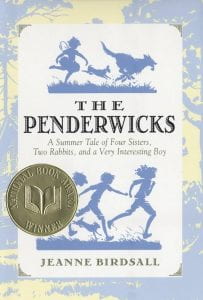 The Penderwicks: A Summer Tale of Four Sisters, Two Rabbits, and a Very Interesting Boy by Jeanne Birdsall tells a charming story about the Penderwick sisters – Rosalind, Skye, Jane and Batty – during their summer vacation at Arundel Cottage in Massachusetts.
The Penderwicks: A Summer Tale of Four Sisters, Two Rabbits, and a Very Interesting Boy by Jeanne Birdsall tells a charming story about the Penderwick sisters – Rosalind, Skye, Jane and Batty – during their summer vacation at Arundel Cottage in Massachusetts.
 What instrument would you want to learn to play- the guitar, the piano, or how about the saxophone? For Jeremiah Birnbaum, it’s the banjo. In Banjo of Destiny by Cary Fagan, readers follow Jeremiah, a young boy from a wealthy family with rigid expectations of academic and societal success. One day, he hears the beautiful sound of a banjo and embarks on a journey of self-expression and the courage to stay true to himself despite his parents’ disapproval of playing the banjo.
What instrument would you want to learn to play- the guitar, the piano, or how about the saxophone? For Jeremiah Birnbaum, it’s the banjo. In Banjo of Destiny by Cary Fagan, readers follow Jeremiah, a young boy from a wealthy family with rigid expectations of academic and societal success. One day, he hears the beautiful sound of a banjo and embarks on a journey of self-expression and the courage to stay true to himself despite his parents’ disapproval of playing the banjo. The Seven Husbands of Evelyn Hugo by Taylor Jenkins Reid chronicles the scandalous life of Hollywood star Evelyn Hugo and her search for love across seven marriages. As she reveals her story to journalist Monique Grant, who is navigating her own relationship struggles, Evelyn exposes the hidden sacrifices of fame, the cost of success, and the difference between public image and personal truth.
The Seven Husbands of Evelyn Hugo by Taylor Jenkins Reid chronicles the scandalous life of Hollywood star Evelyn Hugo and her search for love across seven marriages. As she reveals her story to journalist Monique Grant, who is navigating her own relationship struggles, Evelyn exposes the hidden sacrifices of fame, the cost of success, and the difference between public image and personal truth.
 I am currently reading “The Ballad of Songbirds and Snakes”. Definitely a book I don’t want to put down. I previously read the other books in the series and found this to be very well-written with an amazing storyline! The author tells a story about 18-year-old Coriolanus Snow. Now, if you haven’t read the previous books in the series, Snow was considered an evil dictator of the Capital. In The Ballad of Songbirds and Snakes, he’s simply a student who wants to make a good impression and receive good grades. Coriolanus’s goal is to succeed as a mentor to a woman named Lucy Gray who is from District 12, which was considered to be one of the poorest districts. The only way for him to be successful is to keep Lucy Gray alive in the Hunger Games where there is only one tribute standing. Although that is one of his goals, other feelings get to him and may change his path…
I am currently reading “The Ballad of Songbirds and Snakes”. Definitely a book I don’t want to put down. I previously read the other books in the series and found this to be very well-written with an amazing storyline! The author tells a story about 18-year-old Coriolanus Snow. Now, if you haven’t read the previous books in the series, Snow was considered an evil dictator of the Capital. In The Ballad of Songbirds and Snakes, he’s simply a student who wants to make a good impression and receive good grades. Coriolanus’s goal is to succeed as a mentor to a woman named Lucy Gray who is from District 12, which was considered to be one of the poorest districts. The only way for him to be successful is to keep Lucy Gray alive in the Hunger Games where there is only one tribute standing. Although that is one of his goals, other feelings get to him and may change his path… Described as Narnia-like with a Canadian Indigenous twist, The Barren Grounds is a story that follows two Indigenous foster kids living in Winnipeg as they embark on a fantastical adventure while navigating their identity, belonging, and reclaiming lost culture.
Described as Narnia-like with a Canadian Indigenous twist, The Barren Grounds is a story that follows two Indigenous foster kids living in Winnipeg as they embark on a fantastical adventure while navigating their identity, belonging, and reclaiming lost culture.

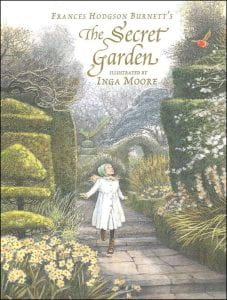 The Secret Garden is a classic story that tells the tale of Mary Lennox- a spoiled, lonely little girl, who is sent to live with her reclusive uncle in Yorkshire after her parents’ sudden death. At first, her new life is very cold and sad (the mansion is gloomy/bleak, Mary is neglected), however everything changes for her when she discovers a locked up, secret garden somewhere on the property. With the help of her sickly cousin Colin and a local boy with a passion for nature named Dickon, the trio work hard to restore the garden and its magic – however, it seems that, in the end, it is the garden itself that works its magic, healing and transforming the children in ways they never expected.
The Secret Garden is a classic story that tells the tale of Mary Lennox- a spoiled, lonely little girl, who is sent to live with her reclusive uncle in Yorkshire after her parents’ sudden death. At first, her new life is very cold and sad (the mansion is gloomy/bleak, Mary is neglected), however everything changes for her when she discovers a locked up, secret garden somewhere on the property. With the help of her sickly cousin Colin and a local boy with a passion for nature named Dickon, the trio work hard to restore the garden and its magic – however, it seems that, in the end, it is the garden itself that works its magic, healing and transforming the children in ways they never expected.

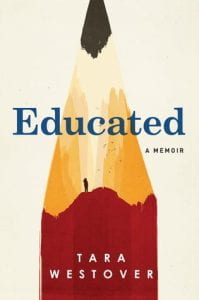 Educated is a memoir by Tara Westover. The first part of the book recounts her childhood, growing up in Idaho. Her father was a mormon survivalist who was constantly paranoid about the government, the medical system, the illuminati, and preparing for the end of the world. Tara never attended school, and instead spent her childhood between working for her father in the junkyard, where safety was constantly neglected, and working for her mother developing herbal medicines. The lack of safety and care given by her parents lead to many severe injuries for her parents and siblings, made even more severe by their refusal to go to a hospital or see a doctor. Although she was never given a formal education at home, with the encouragement of one of her older brothers, Tara managed to take a college admissions test and be accepted to BYU.
Educated is a memoir by Tara Westover. The first part of the book recounts her childhood, growing up in Idaho. Her father was a mormon survivalist who was constantly paranoid about the government, the medical system, the illuminati, and preparing for the end of the world. Tara never attended school, and instead spent her childhood between working for her father in the junkyard, where safety was constantly neglected, and working for her mother developing herbal medicines. The lack of safety and care given by her parents lead to many severe injuries for her parents and siblings, made even more severe by their refusal to go to a hospital or see a doctor. Although she was never given a formal education at home, with the encouragement of one of her older brothers, Tara managed to take a college admissions test and be accepted to BYU.

 Geronimo Stilton, : The Kingdom Of Fantasy #3; The Amazing Voyage, is a critically acclaimed novel which looks at the narrated story of Geronimo Stilton’s third visit to the kingdom of fantasy. Queen Blossom, queen of the fairies is in trouble, and Mr. Stilton must travel across the 7 kingdoms to help the queen of the fairies, and restore balance within the Kingdom of Fantasy. Along the way, he faces many challenges and obstacles that help him develop the skills and gain allies that will help him with his final task.
Geronimo Stilton, : The Kingdom Of Fantasy #3; The Amazing Voyage, is a critically acclaimed novel which looks at the narrated story of Geronimo Stilton’s third visit to the kingdom of fantasy. Queen Blossom, queen of the fairies is in trouble, and Mr. Stilton must travel across the 7 kingdoms to help the queen of the fairies, and restore balance within the Kingdom of Fantasy. Along the way, he faces many challenges and obstacles that help him develop the skills and gain allies that will help him with his final task. Charlotte’s Web by E.B. White is a novel that tells the story of a pig saved from slaughter by an eight-year-old girl named Fern. Fern takes full responsibility for the little piglet, names him Wilbur, and carefully tends to him. However, as Wilbur grows, he is moved to her uncle’s farm since he outgrows his space at Fern’s home. On the farm, Wilbur adjusts to life among other animals but soon learns he is destined to be eaten for Christmas, which causes him great distress. Charlotte, a wise spider, notices his despair and weaves a message into her web. This message attracts attention, and the farm owners ultimately decide to spare Wilbur’s life. Sadly, Wilbur learns that Charlotte is ill, and after laying her eggs, she can no longer return to the farm. Wilbur decides to take her eggs back with him, where he later enjoys the company of Charlotte’s children on the farm.
Charlotte’s Web by E.B. White is a novel that tells the story of a pig saved from slaughter by an eight-year-old girl named Fern. Fern takes full responsibility for the little piglet, names him Wilbur, and carefully tends to him. However, as Wilbur grows, he is moved to her uncle’s farm since he outgrows his space at Fern’s home. On the farm, Wilbur adjusts to life among other animals but soon learns he is destined to be eaten for Christmas, which causes him great distress. Charlotte, a wise spider, notices his despair and weaves a message into her web. This message attracts attention, and the farm owners ultimately decide to spare Wilbur’s life. Sadly, Wilbur learns that Charlotte is ill, and after laying her eggs, she can no longer return to the farm. Wilbur decides to take her eggs back with him, where he later enjoys the company of Charlotte’s children on the farm.

 dent mischief and manipulation for revenge.
dent mischief and manipulation for revenge. Summary:
Summary:
 Frying Plantain by Zalika Reid-Benta is a work of realistic fiction set in Toronto’s “Little Jamaica” neighbourhood (Eglinton West). It follows the main character, Kara Davis, as she deals with her family life and moves from elementary to high school. It follows her experiences as she deals with her strict mother, as well as the unique family dynamics that shape her relationship with her grandparents. It also delves into the transition from child to adolescent as Kara has to navigate her preteen and teen years in school. She struggles with challenges of growing up combined with challenges relating to her Canadian/Jamaican identity. Over the course of the book, Kara seeks to define and redefine herself based on all of the life experiences she has to endure. This book was particularly interesting to me, as it was set in the Eglinton West area where I grew up and went to school. I had never seen/read any material which focused on people with such similar identities to my own, so I had a special connection to this book. I had a sense of nostalgia every time another street name or store I recognized was mentioned.
Frying Plantain by Zalika Reid-Benta is a work of realistic fiction set in Toronto’s “Little Jamaica” neighbourhood (Eglinton West). It follows the main character, Kara Davis, as she deals with her family life and moves from elementary to high school. It follows her experiences as she deals with her strict mother, as well as the unique family dynamics that shape her relationship with her grandparents. It also delves into the transition from child to adolescent as Kara has to navigate her preteen and teen years in school. She struggles with challenges of growing up combined with challenges relating to her Canadian/Jamaican identity. Over the course of the book, Kara seeks to define and redefine herself based on all of the life experiences she has to endure. This book was particularly interesting to me, as it was set in the Eglinton West area where I grew up and went to school. I had never seen/read any material which focused on people with such similar identities to my own, so I had a special connection to this book. I had a sense of nostalgia every time another street name or store I recognized was mentioned. The Bad Beginning is the first book in Lemony Snicket’s series of thirteen children’s novels, A Series of Unfortunate Events. The book follows the lives of orphans Violet, Klaus, and Sunny Baudelaire after their parents’ mysterious death by fire. The orphans must use their talents and cunning to escape from the clutches of the evil Count Olaf, an abusive relative who assumes legal guardianship over the children in order to steal their inheritance. Over the course of their escape, the Baudelaire children uncover dark family secrets and a deep conspiracy involving a secret society. Growing up, I loved this series for its dark humour, absurdism, and sarcastic tone. I also loved how it does not talk down to children – it deals with dark subject matter and often depicts children as being more competent and resourceful than the adults who surround them. This book got me into the genre of gothic fiction. I would go on to read gothic classics such as Shirley Jackson’s We Have Always Lived in the Castle and Bram Stoker’s Dracula in the years following my introduction to this series. Therefore, I would highly recommend this book to any child (or adult) with a taste for the macabre.
The Bad Beginning is the first book in Lemony Snicket’s series of thirteen children’s novels, A Series of Unfortunate Events. The book follows the lives of orphans Violet, Klaus, and Sunny Baudelaire after their parents’ mysterious death by fire. The orphans must use their talents and cunning to escape from the clutches of the evil Count Olaf, an abusive relative who assumes legal guardianship over the children in order to steal their inheritance. Over the course of their escape, the Baudelaire children uncover dark family secrets and a deep conspiracy involving a secret society. Growing up, I loved this series for its dark humour, absurdism, and sarcastic tone. I also loved how it does not talk down to children – it deals with dark subject matter and often depicts children as being more competent and resourceful than the adults who surround them. This book got me into the genre of gothic fiction. I would go on to read gothic classics such as Shirley Jackson’s We Have Always Lived in the Castle and Bram Stoker’s Dracula in the years following my introduction to this series. Therefore, I would highly recommend this book to any child (or adult) with a taste for the macabre.
 Charlotte’s Web is a timeless story that draws readers into the charming world of a pig named Wilbur and his friendship with a wise spider, Charlotte. Centered on a small farm, the story unfolds through moments of kindness, bravery, and the bonds we build with others. When Wilbur’s life is at risk, Charlotte uses her web to weave messages that not only save Wilbur but inspire hope and wonder among the people around them.
Charlotte’s Web is a timeless story that draws readers into the charming world of a pig named Wilbur and his friendship with a wise spider, Charlotte. Centered on a small farm, the story unfolds through moments of kindness, bravery, and the bonds we build with others. When Wilbur’s life is at risk, Charlotte uses her web to weave messages that not only save Wilbur but inspire hope and wonder among the people around them.